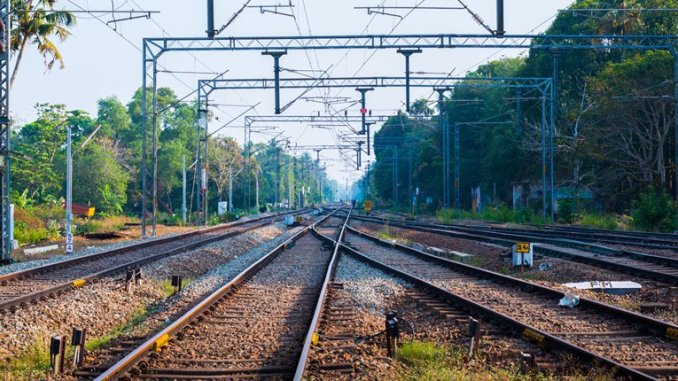
European Train Control System (ETCS):
Introduction: European Railway Traffic Management System (ERTMS) is evolved to harmonize cross-border rail connections for seamless operations across European nations. ERTMS is stated to be the most per formant train control system which brings significant advantages in terms of safety, reliability, punctuality and traffic capacity. ERTMS is evolving as a global standard. Many countries outside Europe – US, China, Taiwan, South Korea and Saudi Arabia have adopted ERTMS standards for train traffic command and control.
ETCS (European Train Control System) is a train control system designed to replace all existing national systems on the Trans European Rail Network. The ETCSs system enables trains equipped with onboard units from different suppliers to operate freely over track equipped by the same/different suppliers. It consists of both onboard and trackside subsystems, with a choice of transmission system for the communication between the two.
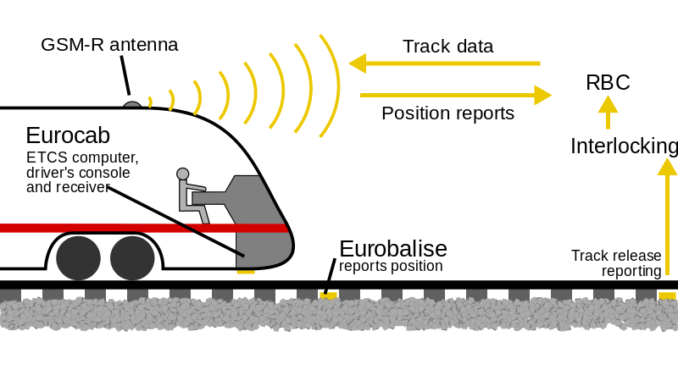
ETCS Level 2 schematic (Image Credit: Wikipedia)
How ETCS can be use: The functional and system requirements for ETCS are contained in two documents, the Functional Requirements Specification (FRS) and the System Requirements Specification (SRS). The FRS is produced by the operators (EEIG) and in theory is the base document for the creation of the SRS by the suppliers (UNISIG) but in some cases the relationship has been the other way round. The functional and system requirements for ETCS are contained in two documents, the Functional Requirements Specification (FRS) and the System Requirements Specification (SRS). The FRS is produced by the operators (EEIG) and in theory is the base document for the creation of the SRS by the suppliers (UNISIG) but in some cases the relationship has been the other way round.
The functional and system requirements for ETCS are contained in two documents, the Functional Requirements Specification (FRS) and the System Requirements Specification (SRS). The FRS is produced by the operators (EEIG) and in theory is the base document for the creation of the SRS by the suppliers (UNISIG) but in some cases the relationship has been the other way round. ETCS has two components – Line side Equipment (LSE) and Onboard Equipment (OBE). Basic ETCS Application Level is Level 0 where locomotives have been fitted with OBE and no LSE has been provided. In Level 0, ETCS will do limited monitoring – monitoring of Max Speed.
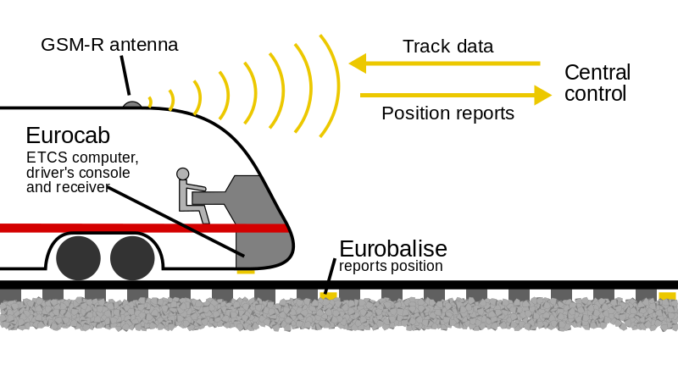
ETCS Level 3 schematic (Image Credit: Wikipedia)
Application Levels: Signaling component of ERTMS has basically four components – European Train Control System (ETCS) with Automatic Train Protection System, Global System GSM-R, European Traffic Management Layer (ETML) and European Operating Rules (EOR).
ETCS is not a signaling itself, but provides a layer over existing signaling. It has 5 application levels and 16 operating modes. Each application level defines level of protection to trains. GSM-R is though a separate element; ETCS make use of GSM-R for its voice and data communication. Different levels (STM, 0, 1, 2 and 3) have been defined to allow each individual railway administration to select the appropriate ETCS application trackside, according to their strategies, to their trackside infrastructure and to the required performance. These levels mainly differ in the trackside and communication systems that are used, and in which functions are processed in the trackside and in the on-board equipment respectively.There are four application levels to be considered; levels 0, STM, 1 and 2. Level 3 is not currently being offered by the suppliers by mutual agreement in order to focus on the other levels.
Level 1 is where OBE on Locomotives and LSE are provided. In Level 2, GSM-R over a fixed network is required in addition to OBE and LSEs and Line side signals are not mandatory. Level 0, 1, and 2 work on fixed block concept where train sections have been demarcated with signals or signages. In Level 3, moving block in place of fixed block will be mandated. Level STM is meant to provide interface to trackside existing national protection systems AWS, TPWS & TPWS+ (UK) and OBE.
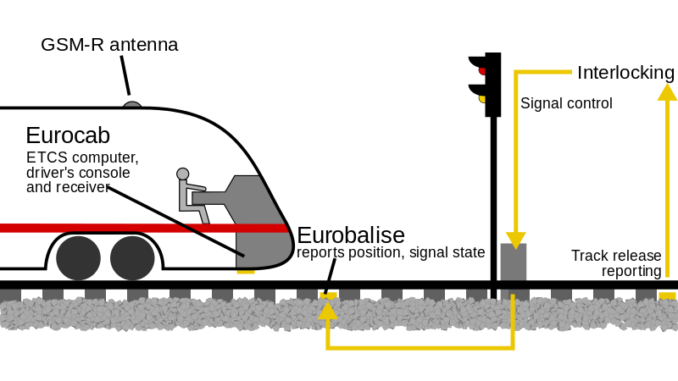
ETCS Level 1 schematic (Image Credit: Wikipedia)
How can Indian Railways use ETCS: The railways earlier decided that 100% ETCS over the next six years and give the contract in one go, giving the suppliers the benefit of economies of scale. The Railway Board has approved the proposal of ETCS (European Train Control System) level 2 signaling between Ghaziabad and Mughalsarai, since the Delhi-Mughalsarai route has high traffic density, modern signaling will help in enhancement of safety. The capacity utilization on this route is 150% and the punctuality is also the worst among the 17 zones of Indian Railway. Modern signaling will help to reduce congestion in rail network and increase the line capacity by 40%-50%. It will also improve the punctuality of train delays sue to automated signaling real-time information of train movements.
The railway tested the ETCS level 1 on total 342km from Agra-Delhi, Chennai-Suburban railway and Kolkata Metro, where in locomotives are fitted with screens that receive intermittent message about signals ahead through track-side devices. This mitigates the risk of locomotive pilot’s error of running over signals due to fog or human error, or over-speeding as the locomotive comes to a halt upon making error. According to the railway official, the per km cost of implementing the ETCS level 2 is 30% higher with the ETCS level 1.
Train Protection & Warning System (TPWS):
Introduction: TPWS primarily offers additional safety in a fully automatic signal circuit and comprises on-board computer consoles or the Driver-Machine Interface. The system will be connected to wireless track-side Balise devices that employ electromagnetic induction and transmits the aspect information of line side Signals to on-board. A standard TPWS facilitates trains to run at maximum permitted speed and allows train drivers to slow down and run at safe speed levels.
The TPWS system in IR is based on European Rail Traffic Management System (ERTMS-Level 1) technology that will create a signaling loop to warn train drivers about the obstacles ahead, as well as control the speed in case of emergency. The system will also activate the train braking system automatically if the driver fails to notice the warning signs, and help regulate speed if a train is travelling too fast on the approach to certain speed restrictions.
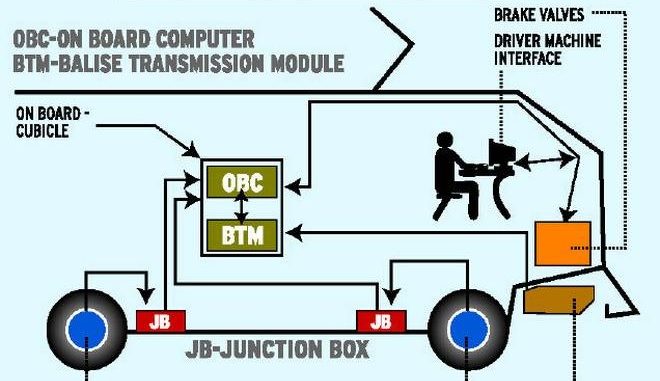
Image Credit: Southern Railway
How TPWS works: TPWS will be provided on sections equipped with Multi Aspect Color Light Signaling and train driver will follow Line Side signals as per prevalent operating rules. Provision of TPWS will be an additional safety aid to the train driver to prevent consequences arising out of Signal Passing at Danger (SPAD) and to control train speed within specified limits.
TPWS is a data-driven system; it is of the utmost importance that the data held by both the ETCS trackside equipment and ETCS onboard equipment is correct and up-to-date. This requires robust procedures to ensure:
- Raw information is measured accurately
- Raw data is transposed accurately into a form used by ETCS equipment
- Transposed data is correctly entered into ETCS equipment
- Data is stored securely with appropriate safeguards, change control and records management
- Changes to infrastructure are promptly reflected in the data held by ETCS equipment.
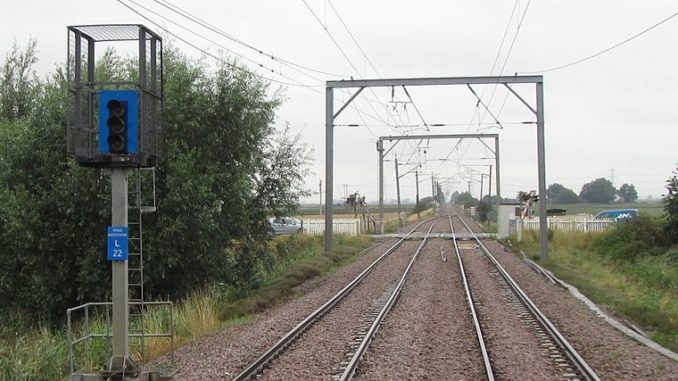
SPAD indicator (Image Credit: Wikipedia)
How Indian Railways can use TPWS: Indian Railways is working towards making the train travel faster and safer in trunk routes by introducing Train Protection and Warning System (TPWS) on 3,330 RKMs at an estimated cost of Rs 2,000 Crores. The aim of this paper is to understand the aspects in speedy implementation of TPWS on IR. This necessitates understanding basic concepts of TPWS, preparation detailed estimates, tendering, execution of works including testing & commissioning and maintenance aspects. An attempt is made to capture these aspects as far as possible so as to benefit the IR Engineers who are engaged in implementation of TPWS in their respective railway.
Indian railways had commissioned a TPWS system on trial basis for the EMU service on mixed tracks on the S.Rly in 2009, providing ERTMS-Level 1 Balize based control linked to the aspects of each Automatic signal encountered by the EMU trains. Since this was a retro-fit on existing aged EMUs with 25 KV A.C traction, a number of problems due to EMC/EMI issues have cropped up which are yet to be fully solved and efforts for required level of reliability and availability as per ERTMS are continuing.
As per the Action Plan 2022 issued by Railway Board, TPWS (ETCS Level-1) system to be introduced on 10,000 RKMs on IR by 2022. The need of IR today is to quickly deploy a train protection system with basic features of SPAD (Signal Passed at Danger) protection and availability of information of ahead signal for safe train operations during foggy conditions. As an immediate priority, Automatic Block Signaling Sections need to be covered first with TPWS coverage since such sections have higher chances of human errors on part of drivers resulting into accidents as trains run closer to each other.
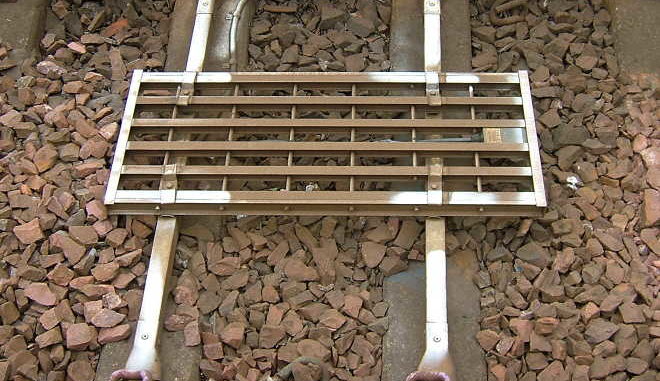
A TPWS transmitter loop, one of a pair that form an Overspeed Sensor System (OSS)
(Image Credit: Wikipedia)
Comparing ETCS and TWPS briefly : TPWS has the capability to control the speed of the train in accordance with the sectional permitted speed and signal aspect ahead by automatic actuation of brakes, in case loco pilot fails to do so in time, therefore, it mitigates safety risk of accidents collisions due to loco pilots error of signal passing at danger or over speeding. A pair of electronic loops is placed 50–450 meters on the approach side of the signal, energized when it is at danger. The distance between the loops determines the minimum speed at which the on board equipment will apply the train’s emergency brakes. When the train’s TPWS receiver passes over the first loop a timer begins to count down. If the second loop is passed before the timer has reached zero, the TPWS will activate. The further the pair of loops is from the signal, the more widely spaced they will be, there is another pair of loops at the signal, also energized when the signal is at danger. These are placed together and will stop a train that runs past the signal.
Whereas, ETCS is not just signaling system itself, but it provides an additional layer over existing signaling. It has 5 application level and 16 operating modes and each application level can define the protection of trains. A variant of Level 3 is ERTMS regional, which has the option to be used with virtual fixed blocks or with true moving block signaling. It was early defined and implemented in a cost sensitive environment in Sweden. In 2016 with SRS 3.5+ it was adopted by core standards and is now officially part of Baseline 3 Level 3.

